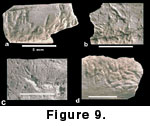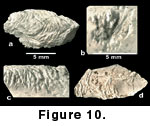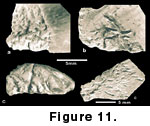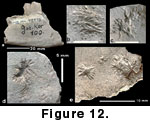THE SITE OF DETAN
 Plant and vertebrate remains from the
sites of Detan, Dvérce, Valec, Vrbice, and others are interbedded in the
lowermost layers of the Doupov Mountains stratovolcano, which were originally
exposed at Altes Heu (Laube 1899). The locality of Altes Heu, famous as the
site near Valec originally considered to be Miocene, is close to a drainage
cutting through strata of the same subaerial volcanic tuffs exposed in 1970 at
the Detan clay pit, ≈300 m to the west. At Dvérce-Wärzen (Wenz 1917),
mammal fossils (most importantly, the small anthracothere Elomeryx crispus
crispus) are found in irregular lenses of tuffaceous limestones rich
in lacustrine molluscs and with rare freshwater fishes, imprints of leaves,
calcified wood, and casts of fruits and rare molds of hickory (Carya)
nuts ( Figure 2).
Plant and vertebrate remains from the
sites of Detan, Dvérce, Valec, Vrbice, and others are interbedded in the
lowermost layers of the Doupov Mountains stratovolcano, which were originally
exposed at Altes Heu (Laube 1899). The locality of Altes Heu, famous as the
site near Valec originally considered to be Miocene, is close to a drainage
cutting through strata of the same subaerial volcanic tuffs exposed in 1970 at
the Detan clay pit, ≈300 m to the west. At Dvérce-Wärzen (Wenz 1917),
mammal fossils (most importantly, the small anthracothere Elomeryx crispus
crispus) are found in irregular lenses of tuffaceous limestones rich
in lacustrine molluscs and with rare freshwater fishes, imprints of leaves,
calcified wood, and casts of fruits and rare molds of hickory (Carya)
nuts ( Figure 2).
 The most productive site for mammalian
remains is situated in a large clay pit south of the village Detan. The layer
of white sandy kaoline clay is covered by 45 to 50 m of basaltic tuff ( Figure 3
). The tuff-clay contact is sharp in
most places. The basal beds of the tuff sequence exhibit both subaerial and
lacustrine facies along the flat southern slopes of the volcano. All tuff
layers are altered and slightly calcareous. Montmorillonite is the most
prevalent diagenetic clay mineral. Altered books of biotite and drops of
volcanic glass are locally present in the fossiliferous beds.
The most productive site for mammalian
remains is situated in a large clay pit south of the village Detan. The layer
of white sandy kaoline clay is covered by 45 to 50 m of basaltic tuff ( Figure 3
). The tuff-clay contact is sharp in
most places. The basal beds of the tuff sequence exhibit both subaerial and
lacustrine facies along the flat southern slopes of the volcano. All tuff
layers are altered and slightly calcareous. Montmorillonite is the most
prevalent diagenetic clay mineral. Altered books of biotite and drops of
volcanic glass are locally present in the fossiliferous beds.
Aquatic molluscs are missing from the
fossiliferous level in the Detan clay pit, although they are abundant in the
nearby fine-grained lacustrine facies found at Valec and Dvérce. Leaf imprints
are rare, but parts of calcified woody roots, some in situ, are common in some
parts of the outcrop. Small pieces of wood charcoal are present but very
rarely. Aragonite pseudomorphs, apparently of wood branches and stems (diameter
= 100 to 150 mm) are occasionally found.
 Mammal bones at Detan are extremely
fragile, fragmented but not abraded, and widely scattered through the basal ash
layers. The only example of articulation is a partial vertebral column of a
snake in situ. Non-mammalian remains are rare. In the upper part of the ash
sequence several large, thick, plastron plates of the giant turtle Geochelone
were preserved. A small crocodilian is represented by a dermal plate. Bones and dentine of mammals are white, but enamel is light brown with black
dendrites.
Mammal bones at Detan are extremely
fragile, fragmented but not abraded, and widely scattered through the basal ash
layers. The only example of articulation is a partial vertebral column of a
snake in situ. Non-mammalian remains are rare. In the upper part of the ash
sequence several large, thick, plastron plates of the giant turtle Geochelone
were preserved. A small crocodilian is represented by a dermal plate. Bones and dentine of mammals are white, but enamel is light brown with black
dendrites.
Age and Correlation
 The
biochronologic age of the fauna is determined by the presence of significant
mammalian taxa (Table 1,
Figure 4,Figure 5), especially the rodents Eucricetodon,
Paracricetodon, Pseudocricetodon, Eomys, Plesispermophilus, Palaeosciurus,
Suevosciurus, and the artiodactyls Gelocus, Entelodon, Lophiomeryx,
Anthracotherium, and Elomeryx. This assemblage indicates an age in
the mammalian Paleogene zone MP 21. Arguing for placement in the older portion
of MP 21 are the index species Entelodon antiquum and the general
evolutionary level of some rodent species. MP 21 falls within the early
Oligocene, in the Stampian (Suevian) stage, and after the Grand Coupure. A K/Ar date of 37.5 Ma was determined for Biozone MP 21 from unweathered
biotite from the mammal-bearing horizon at Detan (Fejfar 1987,
Fejfar and Storch 1994). Correlated European localities include Hoogbutsel (Belgium), Ronzon, Aubrelong 1, Villebramar, and Soumaille (France),
and the Bavarian karst fissures of Möhren 13 and 19 (Fejfar 1987).
The
biochronologic age of the fauna is determined by the presence of significant
mammalian taxa (Table 1,
Figure 4,Figure 5), especially the rodents Eucricetodon,
Paracricetodon, Pseudocricetodon, Eomys, Plesispermophilus, Palaeosciurus,
Suevosciurus, and the artiodactyls Gelocus, Entelodon, Lophiomeryx,
Anthracotherium, and Elomeryx. This assemblage indicates an age in
the mammalian Paleogene zone MP 21. Arguing for placement in the older portion
of MP 21 are the index species Entelodon antiquum and the general
evolutionary level of some rodent species. MP 21 falls within the early
Oligocene, in the Stampian (Suevian) stage, and after the Grand Coupure. A K/Ar date of 37.5 Ma was determined for Biozone MP 21 from unweathered
biotite from the mammal-bearing horizon at Detan (Fejfar 1987,
Fejfar and Storch 1994). Correlated European localities include Hoogbutsel (Belgium), Ronzon, Aubrelong 1, Villebramar, and Soumaille (France),
and the Bavarian karst fissures of Möhren 13 and 19 (Fejfar 1987).
Insect Activity at Detan
 In
the main fossiliferous layer of Detan, in the lower part of the ash sequence,
local concentrations of peculiar drop-like natural casts (diameter = 5 to 8 mm)
are found. These trace fossils are apparently brood cells or pupal cocoons of solitary
burrowing hymenopteran
insects (cf. Sphecoidea or Halictini; Figure 6). Similar trace fossils were recognized at Laetoli, Tanzania (Ritchie 1987).
In
the main fossiliferous layer of Detan, in the lower part of the ash sequence,
local concentrations of peculiar drop-like natural casts (diameter = 5 to 8 mm)
are found. These trace fossils are apparently brood cells or pupal cocoons of solitary
burrowing hymenopteran
insects (cf. Sphecoidea or Halictini; Figure 6). Similar trace fossils were recognized at Laetoli, Tanzania (Ritchie 1987).
 A unique black lens (about 1.5 m wide, 0.6
m high) was discovered in the
lower part of the ash sequence
during fieldwork in 2000. The shape of the lens is oval, with a distinct
reddish zone on its surface (Figure 7). The lens matrix is composed of hard,
calcareous, black Mn-Fe oxides, with less resistant pockets of sediment. The
lens contains shiny black shells of terrestrial molluscs, which are otherwise
completely unknown in the Detan site, along with a concentration of crushed
small bones and rare rodent molars, both light gray in color.
A unique black lens (about 1.5 m wide, 0.6
m high) was discovered in the
lower part of the ash sequence
during fieldwork in 2000. The shape of the lens is oval, with a distinct
reddish zone on its surface (Figure 7). The lens matrix is composed of hard,
calcareous, black Mn-Fe oxides, with less resistant pockets of sediment. The
lens contains shiny black shells of terrestrial molluscs, which are otherwise
completely unknown in the Detan site, along with a concentration of crushed
small bones and rare rodent molars, both light gray in color.
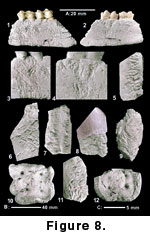 Within the black
lens, the most prevalent mammal is the small dormouse Gliravus and
Bransatoglis. Paracricetodon,
Pseudocricetodon, Eomys, and indeterminate insectivore molars are rare and
partly crushed. The lens is interpreted as the remnant of an insect colony,
possibly that of termites, because within the hard matrix of the lens, passages
reminiscent of those in termitaries occur.
Within the black
lens, the most prevalent mammal is the small dormouse Gliravus and
Bransatoglis. Paracricetodon,
Pseudocricetodon, Eomys, and indeterminate insectivore molars are rare and
partly crushed. The lens is interpreted as the remnant of an insect colony,
possibly that of termites, because within the hard matrix of the lens, passages
reminiscent of those in termitaries occur.
Bone and dentine surfaces from Detan show
peculiar traces on unweathered surfaces (Figure 8,
Figure 9,
Figure 10,
Figure 11). These traces are unlike rodent gnawing or
corrosion from plant roots. They
appear most similar to marks seen on bones found in the Pliocene tuffaceous Upper Laetolil beds (3.46 Ma) of Tanzania (Sands 1987,
Watson and Abbey
1986). For comparison, Figure 12 shows a specimen in the Natural History
Museum (Berlin) collected by the 1934-1936
Kohl-Larsen expedition from the Pliocene tuffaceous beds in the southern
Serengeti.

 Plant and vertebrate remains from the
sites of Detan, Dvérce, Valec, Vrbice, and others are interbedded in the
lowermost layers of the Doupov Mountains stratovolcano, which were originally
exposed at Altes Heu (Laube 1899). The locality of Altes Heu, famous as the
site near Valec originally considered to be Miocene, is close to a drainage
cutting through strata of the same subaerial volcanic tuffs exposed in 1970 at
the Detan clay pit, ≈300 m to the west. At Dvérce-Wärzen (Wenz 1917),
mammal fossils (most importantly, the small anthracothere Elomeryx crispus
crispus) are found in irregular lenses of tuffaceous limestones rich
in lacustrine molluscs and with rare freshwater fishes, imprints of leaves,
calcified wood, and casts of fruits and rare molds of hickory (Carya)
nuts ( Figure 2).
Plant and vertebrate remains from the
sites of Detan, Dvérce, Valec, Vrbice, and others are interbedded in the
lowermost layers of the Doupov Mountains stratovolcano, which were originally
exposed at Altes Heu (Laube 1899). The locality of Altes Heu, famous as the
site near Valec originally considered to be Miocene, is close to a drainage
cutting through strata of the same subaerial volcanic tuffs exposed in 1970 at
the Detan clay pit, ≈300 m to the west. At Dvérce-Wärzen (Wenz 1917),
mammal fossils (most importantly, the small anthracothere Elomeryx crispus
crispus) are found in irregular lenses of tuffaceous limestones rich
in lacustrine molluscs and with rare freshwater fishes, imprints of leaves,
calcified wood, and casts of fruits and rare molds of hickory (Carya)
nuts ( Figure 2).





